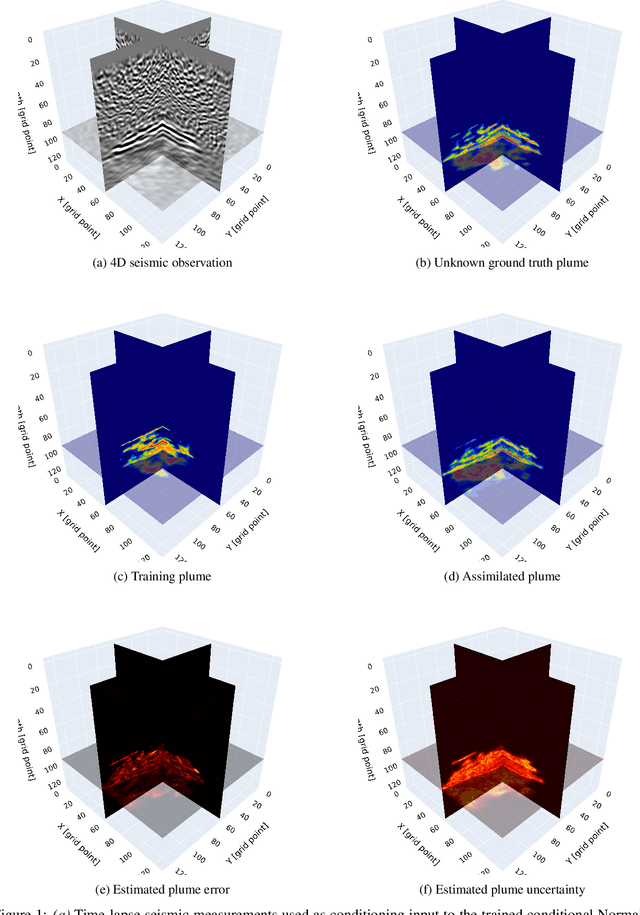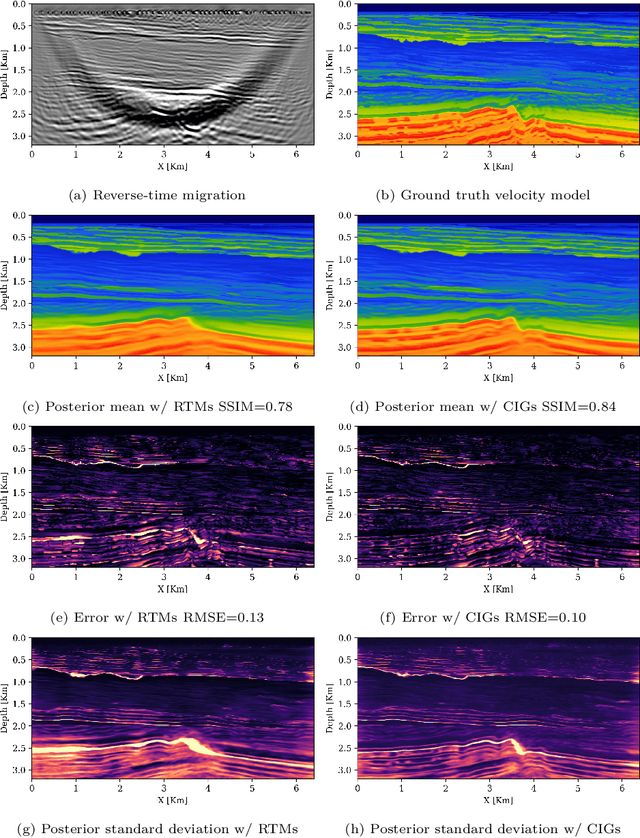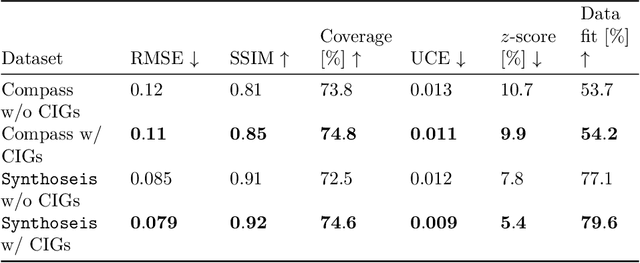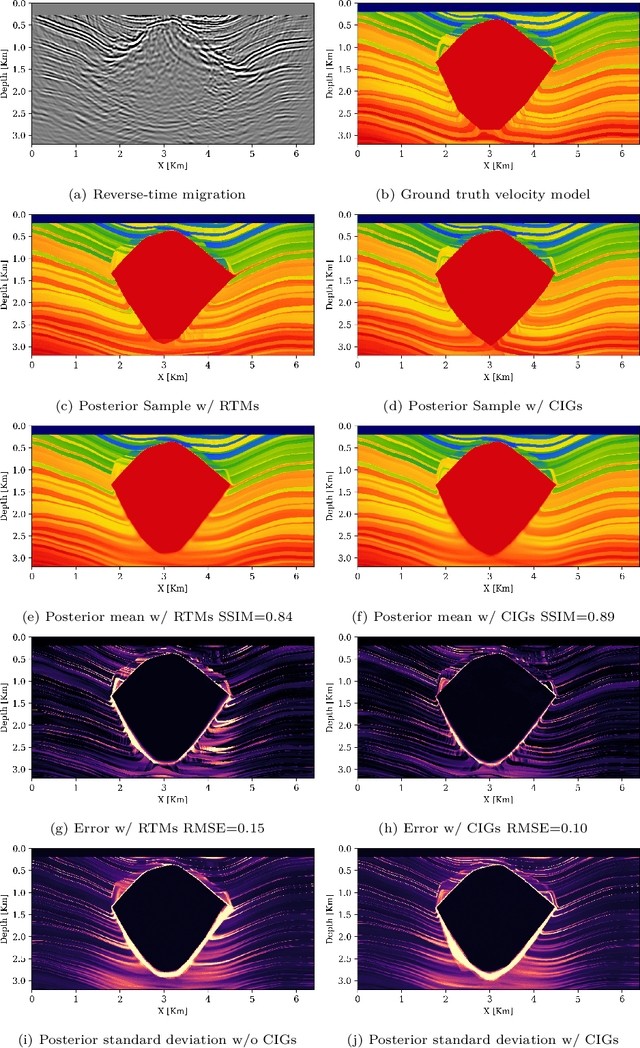Rafael Orozco
Advancing Geological Carbon Storage Monitoring With 3d Digital Shadow Technology
Feb 11, 2025
Abstract:Geological Carbon Storage (GCS) is a key technology for achieving global climate goals by capturing and storing CO2 in deep geological formations. Its effectiveness and safety rely on accurate monitoring of subsurface CO2 migration using advanced time-lapse seismic imaging. A Digital Shadow framework integrates field data, including seismic and borehole measurements, to track CO2 saturation over time. Machine learning-assisted data assimilation techniques, such as generative AI and nonlinear ensemble Bayesian filtering, update a digital model of the CO2 plume while incorporating uncertainties in reservoir properties. Compared to 2D approaches, 3D monitoring enhances the spatial accuracy of GCS assessments, capturing the full extent of CO2 migration. This study extends the uncertainty-aware 2D Digital Shadow framework by incorporating 3D seismic imaging and reservoir modeling, improving decision-making and risk mitigation in CO2 storage projects.
Probabilistic Joint Recovery Method for CO$_2$ Plume Monitoring
Jan 30, 2025Abstract:Reducing CO$_2$ emissions is crucial to mitigating climate change. Carbon Capture and Storage (CCS) is one of the few technologies capable of achieving net-negative CO$_2$ emissions. However, predicting fluid flow patterns in CCS remains challenging due to uncertainties in CO$_2$ plume dynamics and reservoir properties. Building on existing seismic imaging methods like the Joint Recovery Method (JRM), which lacks uncertainty quantification, we propose the Probabilistic Joint Recovery Method (pJRM). By estimating posterior distributions across surveys using a shared generative model, pJRM provides uncertainty information to improve risk assessment in CCS projects.
Machine learning-enabled velocity model building with uncertainty quantification
Nov 14, 2024



Abstract:Accurately characterizing migration velocity models is crucial for a wide range of geophysical applications, from hydrocarbon exploration to monitoring of CO2 sequestration projects. Traditional velocity model building methods such as Full-Waveform Inversion (FWI) are powerful but often struggle with the inherent complexities of the inverse problem, including noise, limited bandwidth, receiver aperture and computational constraints. To address these challenges, we propose a scalable methodology that integrates generative modeling, in the form of Diffusion networks, with physics-informed summary statistics, making it suitable for complicated imaging problems including field datasets. By defining these summary statistics in terms of subsurface-offset image volumes for poor initial velocity models, our approach allows for computationally efficient generation of Bayesian posterior samples for migration velocity models that offer a useful assessment of uncertainty. To validate our approach, we introduce a battery of tests that measure the quality of the inferred velocity models, as well as the quality of the inferred uncertainties. With modern synthetic datasets, we reconfirm gains from using subsurface-image gathers as the conditioning observable. For complex velocity model building involving salt, we propose a new iterative workflow that refines amortized posterior approximations with salt flooding and demonstrate how the uncertainty in the velocity model can be propagated to the final product reverse time migrated images. Finally, we present a proof of concept on field datasets to show that our method can scale to industry-sized problems.
An uncertainty-aware Digital Shadow for underground multimodal CO2 storage monitoring
Oct 02, 2024Abstract:Geological Carbon Storage GCS is arguably the only scalable net-negative CO2 emission technology available While promising subsurface complexities and heterogeneity of reservoir properties demand a systematic approach to quantify uncertainty when optimizing production and mitigating storage risks which include assurances of Containment and Conformance of injected supercritical CO2 As a first step towards the design and implementation of a Digital Twin for monitoring underground storage operations a machine learning based data-assimilation framework is introduced and validated on carefully designed realistic numerical simulations As our implementation is based on Bayesian inference but does not yet support control and decision-making we coin our approach an uncertainty-aware Digital Shadow To characterize the posterior distribution for the state of CO2 plumes conditioned on multi-modal time-lapse data the envisioned Shadow combines techniques from Simulation-Based Inference SBI and Ensemble Bayesian Filtering to establish probabilistic baselines and assimilate multi-modal data for GCS problems that are challenged by large degrees of freedom nonlinear multi-physics non-Gaussianity and computationally expensive to evaluate fluid flow and seismic simulations To enable SBI for dynamic systems a recursive scheme is proposed where the Digital Shadows neural networks are trained on simulated ensembles for their state and observed data well and/or seismic Once training is completed the systems state is inferred when time-lapse field data becomes available In this computational study we observe that a lack of knowledge on the permeability field can be factored into the Digital Shadows uncertainty quantification To our knowledge this work represents the first proof of concept of an uncertainty-aware in-principle scalable Digital Shadow.
ASPIRE: Iterative Amortized Posterior Inference for Bayesian Inverse Problems
May 08, 2024Abstract:Due to their uncertainty quantification, Bayesian solutions to inverse problems are the framework of choice in applications that are risk averse. These benefits come at the cost of computations that are in general, intractable. New advances in machine learning and variational inference (VI) have lowered the computational barrier by learning from examples. Two VI paradigms have emerged that represent different tradeoffs: amortized and non-amortized. Amortized VI can produce fast results but due to generalizing to many observed datasets it produces suboptimal inference results. Non-amortized VI is slower at inference but finds better posterior approximations since it is specialized towards a single observed dataset. Current amortized VI techniques run into a sub-optimality wall that can not be improved without more expressive neural networks or extra training data. We present a solution that enables iterative improvement of amortized posteriors that uses the same networks architectures and training data. The benefits of our method requires extra computations but these remain frugal since they are based on physics-hybrid methods and summary statistics. Importantly, these computations remain mostly offline thus our method maintains cheap and reusable online evaluation while bridging the approximation gap these two paradigms. We denote our proposed method ASPIRE - Amortized posteriors with Summaries that are Physics-based and Iteratively REfined. We first validate our method on a stylized problem with a known posterior then demonstrate its practical use on a high-dimensional and nonlinear transcranial medical imaging problem with ultrasound. Compared with the baseline and previous methods from the literature our method stands out as an computationally efficient and high-fidelity method for posterior inference.
BEACON: Bayesian Experimental design Acceleration with Conditional Normalizing flows $-$ a case study in optimal monitor well placement for CO$_2$ sequestration
Mar 28, 2024

Abstract:CO$_2$ sequestration is a crucial engineering solution for mitigating climate change. However, the uncertain nature of reservoir properties, necessitates rigorous monitoring of CO$_2$ plumes to prevent risks such as leakage, induced seismicity, or breaching licensed boundaries. To address this, project managers use borehole wells for direct CO$_2$ and pressure monitoring at specific locations. Given the high costs associated with drilling, it is crucial to strategically place a limited number of wells to ensure maximally effective monitoring within budgetary constraints. Our approach for selecting well locations integrates fluid-flow solvers for forecasting plume trajectories with generative neural networks for plume inference uncertainty. Our methodology is extensible to three-dimensional domains and is developed within a Bayesian framework for optimal experimental design, ensuring scalability and mathematical optimality. We use a realistic case study to verify these claims by demonstrating our method's application in a large scale domain and optimal performance as compared to baseline well placement.
Probabilistic Bayesian optimal experimental design using conditional normalizing flows
Feb 28, 2024



Abstract:Bayesian optimal experimental design (OED) seeks to conduct the most informative experiment under budget constraints to update the prior knowledge of a system to its posterior from the experimental data in a Bayesian framework. Such problems are computationally challenging because of (1) expensive and repeated evaluation of some optimality criterion that typically involves a double integration with respect to both the system parameters and the experimental data, (2) suffering from the curse-of-dimensionality when the system parameters and design variables are high-dimensional, (3) the optimization is combinatorial and highly non-convex if the design variables are binary, often leading to non-robust designs. To make the solution of the Bayesian OED problem efficient, scalable, and robust for practical applications, we propose a novel joint optimization approach. This approach performs simultaneous (1) training of a scalable conditional normalizing flow (CNF) to efficiently maximize the expected information gain (EIG) of a jointly learned experimental design (2) optimization of a probabilistic formulation of the binary experimental design with a Bernoulli distribution. We demonstrate the performance of our proposed method for a practical MRI data acquisition problem, one of the most challenging Bayesian OED problems that has high-dimensional (320 $\times$ 320) parameters at high image resolution, high-dimensional (640 $\times$ 386) observations, and binary mask designs to select the most informative observations.
InvertibleNetworks.jl: A Julia package for scalable normalizing flows
Dec 20, 2023Abstract:InvertibleNetworks.jl is a Julia package designed for the scalable implementation of normalizing flows, a method for density estimation and sampling in high-dimensional distributions. This package excels in memory efficiency by leveraging the inherent invertibility of normalizing flows, which significantly reduces memory requirements during backpropagation compared to existing normalizing flow packages that rely on automatic differentiation frameworks. InvertibleNetworks.jl has been adapted for diverse applications, including seismic imaging, medical imaging, and CO2 monitoring, demonstrating its effectiveness in learning high-dimensional distributions.
Inference of CO2 flow patterns -- a feasibility study
Nov 01, 2023Abstract:As the global deployment of carbon capture and sequestration (CCS) technology intensifies in the fight against climate change, it becomes increasingly imperative to establish robust monitoring and detection mechanisms for potential underground CO2 leakage, particularly through pre-existing or induced faults in the storage reservoir's seals. While techniques such as history matching and time-lapse seismic monitoring of CO2 storage have been used successfully in tracking the evolution of CO2 plumes in the subsurface, these methods lack principled approaches to characterize uncertainties related to the CO2 plumes' behavior. Inclusion of systematic assessment of uncertainties is essential for risk mitigation for the following reasons: (i) CO2 plume-induced changes are small and seismic data is noisy; (ii) changes between regular and irregular (e.g., caused by leakage) flow patterns are small; and (iii) the reservoir properties that control the flow are strongly heterogeneous and typically only available as distributions. To arrive at a formulation capable of inferring flow patterns for regular and irregular flow from well and seismic data, the performance of conditional normalizing flow will be analyzed on a series of carefully designed numerical experiments. While the inferences presented are preliminary in the context of an early CO2 leakage detection system, the results do indicate that inferences with conditional normalizing flows can produce high-fidelity estimates for CO2 plumes with or without leakage. We are also confident that the inferred uncertainty is reasonable because it correlates well with the observed errors. This uncertainty stems from noise in the seismic data and from the lack of precise knowledge of the reservoir's fluid flow properties.
Solving multiphysics-based inverse problems with learned surrogates and constraints
Jul 18, 2023Abstract:Solving multiphysics-based inverse problems for geological carbon storage monitoring can be challenging when multimodal time-lapse data are expensive to collect and costly to simulate numerically. We overcome these challenges by combining computationally cheap learned surrogates with learned constraints. Not only does this combination lead to vastly improved inversions for the important fluid-flow property, permeability, it also provides a natural platform for inverting multimodal data including well measurements and active-source time-lapse seismic data. By adding a learned constraint, we arrive at a computationally feasible inversion approach that remains accurate. This is accomplished by including a trained deep neural network, known as a normalizing flow, which forces the model iterates to remain in-distribution, thereby safeguarding the accuracy of trained Fourier neural operators that act as surrogates for the computationally expensive multiphase flow simulations involving partial differential equation solves. By means of carefully selected experiments, centered around the problem of geological carbon storage, we demonstrate the efficacy of the proposed constrained optimization method on two different data modalities, namely time-lapse well and time-lapse seismic data. While permeability inversions from both these two modalities have their pluses and minuses, their joint inversion benefits from either, yielding valuable superior permeability inversions and CO2 plume predictions near, and far away, from the monitoring wells.
 Add to Chrome
Add to Chrome Add to Firefox
Add to Firefox Add to Edge
Add to Edge